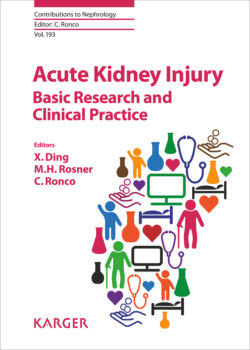Читать книгу Acute Kidney Injury - Basic Research and Clinical Practice - Группа авторов - Страница 31
На сайте Литреса книга снята с продажи.
Existing Literature of Quality Measure in AKI Risk Assessment
ОглавлениеNational institute for health and care excellence published guidelines [21] for ensuring quality and safety in AKI. They were developed with rigorous methodology. Specific questions were raised in a population, intervention, comparison, outcome framework. These guidelines were created indicating that most of AKI is preventable, and that the risk assessment, prevention, and early recognition are key factors to decrease the incidence of AKI, prevalence of chronic kidney disease and related death.
In the recommendations for assessing the risk of AKI, suggestions are classified according to specific patients (Fig. 2).
On the other hand, Rizo-Topete et al. [22] encourage every health care provider to perform the AKI risk assessment no matter where the patient is located. This assessment is ideally situated in the electronic medical record and accessible by all team members. The proposed algorithm is based on the 4 simple steps named the “Fantastic 4” that evaluates the patient systematically and promptly referring them to nephrologists to improve outcome (Fig. 3).
Fig. 2. National institute for health and care excellence (NICE) AKI risk assessment flowchart.
The approach to the patient should be the following:
F1: refer the patient to a “clinical scenario” where the patient’s signs and symptoms and the surrounding circumstances and risks are reviewed and considered;
F2: interview the patient or his/her relatives and review the “past history” with a goal of identifying the level of susceptibility and intensity of exposures;
F3: conduct a “physical examination” on the patient aiming at characterizing hemodynamic instability, volume depletion or fluid overload and signs/source of infection, if any;
F4: analyze “laboratory results” including possible AKI biomarkers to complete the patient risk stratification.
This AKI F4 model is considered collaborated with the electronic medical record to alert caregivers to the risk assessment results.
Fig. 3. The composition of the acute kidney injury risk assessment (ARA) is based on the analysis of 4 following items: actual clinical scenario, past history, physical examination and laboratory analysis.
There are several AKI risk assessment scores in specific fields, like cardiac surgery. AKI is one of the common complications after cardiac surgery with high incidence and mortality. Therefore, early identification is crucial in preventing CSA-AKI. In the last decades, several risk scores were generated to improve the outcome of patients [23–25]. However, further evidence is needed to validate these risk scores in a larger population.
